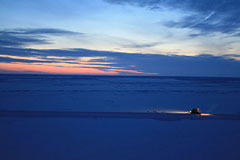

 | |||||||||||
|
|
Journals 2007/2008Jason Pavlich
January 7, 2007 Position 71° 31.428' N 125° 37.242' W Up at 7:15 again, and out on the ice by 8:30. Ice core, surface water, snow, and brine sampling was completed by 10 and soon after we were lifted back into the boat by the ice cage. We have settled into a routine with the new sampling. Sample, carry everything back to the aft lab, change clothes, have hot chocolate, go back to the lab to clean all of the equipment, and finally start running the samples through the filters. By the time all of this is completed, it is time for lunch. After lunch, it's back to the lab to check on the filtrations and to section and shave the ice cores that will be analyzed for trace metals. In the afternoon today, I got the chance to make some contact with the schools back home. At 12:30 I called my sister's fifth grade class at Mill Road Elementary School in Red Hook, NY using the Iridium phone provided by the National Science Foundation. I visited her class the day before my departure and was excited to tell the kids about my adventure thus far. Keeping abreast of my trip by reading my daily journal entries, the students compiled a list of 18 questions to ask me. Questions ranged from the very practical "How can you take pictures with big gloves on?" by Aidan O. to the very scientific "Do chemicals affect the density of water?" by Templeton K. I talked to them for about 25 minutes from the helicopter deck (where I got the best signal) until I was forced inside when the crew brought the helicopter out for an afternoon flight. I hope I was able to answer their questions sufficiently and am looking forward to showing them my pictures when I return. After the call, I headed upstairs to deck 2 to conduct a test video call with my high school. Martin Richard, the Amundsen's electronics guru, helped me configure one of the desktops for video-conferencing and I dialed the high school. After working out the bugs, it was agreed that I will appear live on the high school's in-house morning TV show on Wednesday at 7:45 am EST. After dinner it was back out on the ice. In addition to the usual sampling off the starboard side, Tim Papakyriakou (the chief scientist) asked me to help the Chinese group by drilling some holes in the ice. I didn't have much experience running an ice auger but apparently that is more than they did, so I was asked to help. The Chinese team of Tao, Xiang, and Shujiang Li, are measuring the ability of the Arctic ice to absorb solar radiation. They have constructed a very bright white light source that is shone on the surface of the ice. Light sensors placed beneath the ice (why the holes were needed) measure the amount of light that makes it way through the ice. They work in the darkness of night so as to eliminate any other outside light interference. Since the ice is over 1 meter thick now, an extension had to be attached to the auger. Wojciech's help was necessary since the auger was well above our heads when the drilling started. Since their instrument to be lowered was bigger than the 8" diameters of the drill head, we had to dig four overlapping holes. The Chinese group was extremely appreciative of our assistance. I enjoyed helping them out but at the same time, hope that I won't be asked to do it again. When we broke through to the water below it generated a great deal of slush in digging the next three holes. This puts a lot of strain on the auger's motor and I don't want to be the one holding it when it finally gives out. That is not how I want to be remembered.
While we were on the ice this evening, the crew was putting the final touches on the runway, complete with portable landing lights. The crew also cleared off and extra patch of ice so we could get a little exercise in tomorrow after lunch - soccer on the ice! This will be a good way to wrap up my three week stay in the Arctic. I should get to sleep early to rest up for the big game.
|
||||||||||

